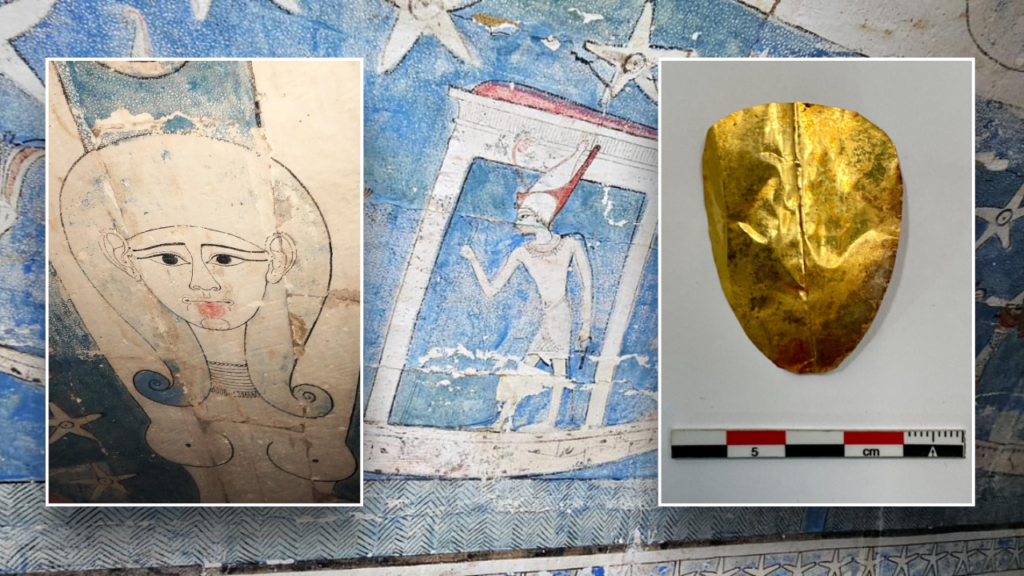In a remarkable development in the field of archaeology, officials have recently unveiled a collection of unusual artifacts discovered at the Al-Bahnasa archaeological site in Egypt’s Minya Governorate. The Egyptian Ministry of Tourism and Antiquities took to Facebook to announce these exciting finds, which include a series of intriguing objects, notably human tongues and nails, both crafted from gold. These artifacts are believed to date back to the Ptolemaic era, a period that spanned from 305 BC to 30 BC, when Macedonian Greeks ruled over Egypt. This era concluded with the onset of Roman authority, signifying a pivotal change in the region’s history.
According to the press release disseminated by the tourism ministry, the excavation has produced not only the aforementioned golden tongues but also a variety of amulets and jars adorned with depictions of ancient Egyptian deities—specifically Ra, Isis, Horus, and Osiris. The announcement highlights the complexity and richness of the finds, painting a picture of a society deeply engaged in religious and cultural practices connected to their beliefs in the afterlife and protection in both life and death. The discovery of 13 gold human tongues, in particular, is striking; these artifacts may reflect ancient rituals aimed at ensuring the deceased could speak in the afterlife, an important aspect of Egyptian burial customs.
A collaborative effort between the University of Barcelona and the University of Chicago has facilitated the excavation, leading to the unearthing of several well-preserved Ptolemaic tombs featuring vibrant engravings and inscriptions. This partnership signifies a convergence of international scholarly efforts to deepen our understanding of ancient Egyptian practices and their implications. The ministry’s statement emphasizes that among the findings were various artifacts, including gold medals associated with mummies from the Ptolemaic era and a plethora of ancient texts and imagery that illuminate prevalent religious rituals of the time.
Among the more fascinating findings reported were two heart scarabs located within a mummy, a critical component in ancient Egyptian funerary practices where heart scarabs are thought to protect the heart during the afterlife journey. In addition, 29 amulets representing the pillars of Ra, as well as scarabs dedicated to deities such as Horus, Thoth, and Isis, were recovered. Notably, there also exists a combination of idols of various deities, further underscoring the syncretic nature of Ptolemaic religious beliefs.
The excavation team further unearthed a stone burial well leading to a central chamber that housed multiple mummies, signifying the existence of an ancient mass cemetery. This aspect of the discovery provides valuable insight into the burial practices of the time, indicating a community that possibly adhered to collective burial traditions. The artworks adorning the walls of one of the discovered chambers are particularly significant; they include depictions of the tomb owner alongside familial figures in the presence of important deities such as Anubis and Osiris, with a striking ceiling painted in blues and whites depicting the sky goddess Nut, surrounded by symbols of divinity.
Previous explorations at the site have already revealed graves dating back to both Greek and Roman eras, along with remnants of an ancient Catholic basilica and the Osireion temple, further emphasizing the long and intricate history of the locale. The excavation mission is committed to continuing its work at this vital archaeological site, with aspirations to uncover more secrets integral to the understanding of this important cultural heritage.
To keep up with lifestyle articles concerning these archaeological developments and other topics of interest, readers are encouraged to visit foxnews.com/lifestyle. Andrea Margolis of Fox News Digital is the writer reporting on these exciting discoveries, inviting story tips and engagement from the public through her email. This collaborative effort of research and reporting highlights the ongoing fascination with Egyptology and the enduring significance of its archaeological contributions to global history.



